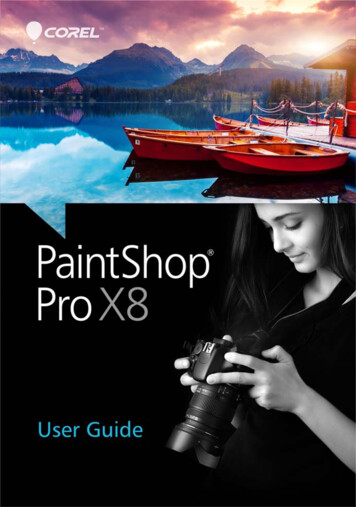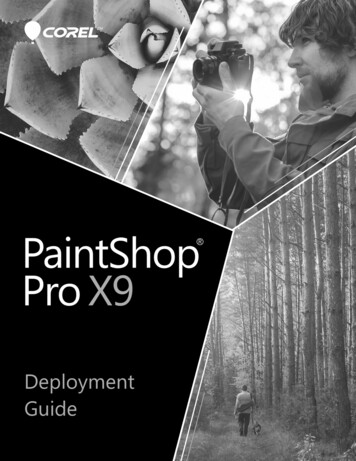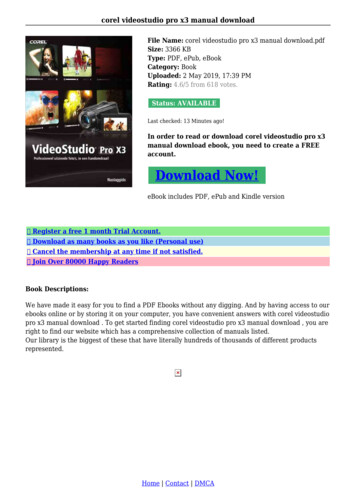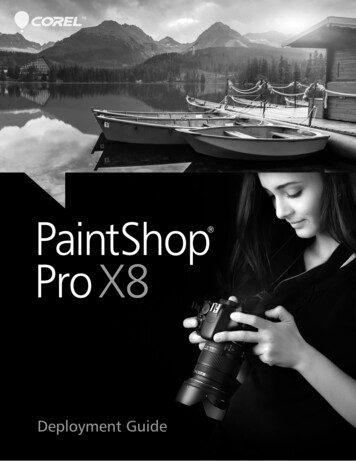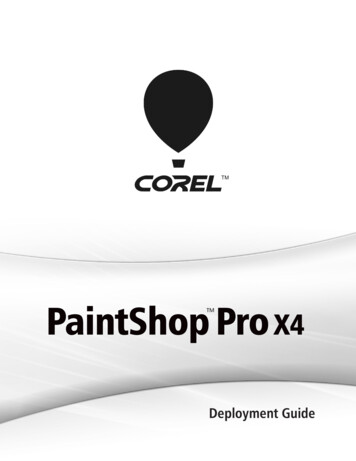
Transcription
Deployment Guide
IntroductionAs you read through this guide,you’ll find that the right column ofeach page contains the maincontent, while the left columncontains the following categories ofinformation:definition — explains theitalicized term or concepttip — presents a helpfuldetail, such as a shortcut,variation, or benefitnote — presents anadditional detail about thespecified topic or taskwarning — presents acrucial detail about thespecified topic or taskThe left column also gives you roomto jot down notes.This guide is intended to help you deploy Corel PaintShop Pro X4(Corporate and Education Edition) to your network as quickly and easily aspossible.IMPORTANT: This guide describes the “GM3” version of the software(part number ending with “03” or higher on your Corel PaintShop Pro X4disc). If you are using an earlier version of the software, please be sure todownload the GM3 patch and apply it to your server image (for generalguidance, see “Patching the server image” on page 15) so that you canenjoy the new GM3 features described in this guide: installing offline Help for all supported languages, and installing theBrazilian Portuguese language module (see page 10) suppressing license-agreement prompts on workstations (see page 11) suppressing registration prompts on workstations (see page 12)ContentsStage 1: Preparing for deployment . . . . . . . . . . . . . . . . . . . . . . . . . . . . . 2Stage 2: Creating the server image . . . . . . . . . . . . . . . . . . . . . . . . . . . . . 3Stage 3: Installing the software . . . . . . . . . . . . . . . . . . . . . . . . . . . . . . . . 5Stage 4: Maintaining the installations . . . . . . . . . . . . . . . . . . . . . . . . . . 14Additional resourcesIf you are new to software deployment or otherwise require more basicinformation on deploying Corel software products, please refer to theCorel Beginner’s Guide to Network Deployment. You can request a copy of thisguide from your Corel Support Services representative.For even more information, see the following Web resources.Web resourceDescriptionCorel website:Information about Corel Corporation andits portfolio of software productsCorel Support Services website:Information about product features,specifications, pricing, availability,services, and technical supportCorel Knowledge Base :A searchable repository of articles writtenby the Corel Support Services m/kbFor help with the Microsoft Windows Installer (MSI) technology that isused to install the software, please refer to the Microsoft website.Deployment GuideIntroduction1
Stage 1: Preparing for deploymentAs used in this guide, theterm “network” signifies twoor more computers that are connectedto each other for the purpose ofexchanging information.To deploy the software to your network as smoothly as possible, you canprepare by doing the following: Check the system requirements for the software. Prepare the server. Prepare the workstations.For details, see below.Checking the software requirementsWorkstations are thecomputers from which theaverage user works, and servers arethe computers that manage theshared resources of the network.To begin, make sure that your server and workstations are eligible for thesoftware. Consult the following: Readme file for the software (if available) product-information page on the Corel website (www.corel.com) any other special instructions for the softwarePreparing the server Make sure that the server meets the minimum system requirements forthe software, and that it has enough free disk space for the installation. Make sure that the operating system on the server has been updatedwith the latest service packs and security patches. Make sure that you have the proper permissions for creating a softwareimage on the server. You must be either a local administrator or anadministrator for the domain that you are managing, and you must haveread/write access to the server location.Preparing the workstationsTo more easily manage theaccess rights of workstationusers, you may want to use GroupPolicy Objects (GPOs, or “systempolicies”). See “Managingpermissions with Group PolicyObjects” on page 5. Make sure that the workstations meet the minimum systemrequirements for the software, and that they have enough free disk spacefor the installation. Make sure that the operating systems on the workstations have beenupdated with the latest service packs and security patches. Make sure that anyone who will be installing the software from theserver image has the proper permissions to do so. To install the softwareon a workstation, you must be either a local administrator or anadministrator for the domain that you are managing, and you must haveread access to the server location.Deployment GuideStage 1: Preparing for deployment2
Stage 2: Creating the server imageA server image, also calledan “administrator image” orsimply an “image,” is a set ofuncompressed application files on theserver that is created from a set ofcompressed files on the installationdisc.After preparing for deployment, you’re ready to create a server image of thesoftware, from which you can install the software to the workstations. (Ifyou want to support multiple installation types, you can even createmultiple server images: one for each desired configuration.)ContentsCreating a server image . . . . . . . . . . . . . . . . . . . . . . . . . . . . . . . . . . . . . . 3Finalizing the server image . . . . . . . . . . . . . . . . . . . . . . . . . . . . . . . . . . . 4Creating a server imageA command line is a textualcommand that lets youspecify desired settings.To create a server image, you run a command line that initializes the softwaresetup and specifies your desired installation settings.To run a command line1On the Windows taskbar, do one of the following: Windows 7 or Windows Vista — Click the Start button, and thenclick All programs Accessories Run. Windows XP — Click Start Run.2Type the command line in the Open box, and then click OK.To create a server image1Insert the installation disc into the DVD drive.If the AutoRun screen opens, click Exit.2Run the following command line, where X: is the DVD drive.X:\Setup.exe /a3Type your user name and serial number (with or without hyphens) in theboxes provided, and then click Next.The customer information that you provide is passed on to theworkstations when the software is deployed to the network. By default,users can change the user name but not the serial number.4Specify a network location for the server image. To change the defaultlocation, type a valid server path in the Network location box, or clickBrowse to browse to a valid network location.5If you want to allow workstations to detect and download productupdates, enable the Product updates check box.6Click Install to begin copying the files to the server.Deployment GuideStage 2: Creating the server image3
If you click Cancel, you are prompted whether to cancel creating theserver image. Cancelling “rolls back” the setup and undoes most of thechanges made; however, some manual clean-up may be required.7Click Finish.You can alsoCreate a serverimage silently(or with limited UI)Use the following command line (where X: is the DVDdrive, image location is the desired location of theserver image, and serial number is the assigned serialnumber for the product):X:\Setup.exeTARGETDIR "image location"SERIALNUMBER "serial number" /a /qProceed with extreme cautionwhen using the /q switch tocreate a server image.The /q switch is used to restrict the amount of the userinterface that appears during installation. For a list ofswitch parameters, see page 7.Create an error logUse the following command line (where log file is thelocation and filename of the log file):X:\Setup.exe /l "log file" /aFor a list of the parameters that are available for the /lswitch, see page 8.Finalizing the server imageTo change the location of aserver image, you must createa new image at the new location.You cannot copy an image from onelocation to another.Before deploying from the server image, you may want to take thefollowing steps.Check for software updatesCheck for software updates, and apply them to the image as necessary. Thisway, you can avoid having to deploy the software twice. For details, seepage 15.Test the imageTest the image with a small subset of workstations before rolling it out toyour entire organization.Deployment GuideStage 2: Creating the server image4
Stage 3: Installing the softwareLooking for command-lineswitches and publicproperties? See “Pushing thesoftware” on page 6.You can install the software on the workstations in two main ways: by having the users themselves install (or “pull”) the software from theserver image to their workstations by using a command line to install (or “push”) the software from theserver image to the workstations on the users’ behalfContentsPulling the software . . . . . . . . . . . . . . . . . . . . . . . . . . . . . . . . . . . . . . . . 5Pushing the software . . . . . . . . . . . . . . . . . . . . . . . . . . . . . . . . . . . . . . . . 6Pulling the softwarePulling the software involveshaving the workstation usersthemselves execute the softwareinstallation and perhaps even choosetheir own installation options.Workstation users themselves can install (or “pull”) the software by usingone of the following methods: browsing to the location of the server image, double-clicking Setup.exe,and following the instructions in the setup. This is the most commonmethod for pulling the software. running a command line that installs the software from the setup on theserver image. Typically, this method is reserved for push-installationscenarios (see page 6).Managing permissions with Group Policy ObjectsGroup Policy Objects(sometimes called “systempolicies”) reside in a centrallocation on a Windows-basednetwork and define how eachworkstation is configured.To install the software, workstation users require administrator-levelprivileges. To assign such privileges, Windows-based networks use GroupPolicy Objects (or “GPOs”): items stored in a central network location andused to automatically update the registry settings on each workstationwhen its user logs in to the network.If you want to give users administrator-level access rights (eithertemporarily or permanently), you may need to configure the GPOs for yournetwork by using a Group Policy Editor.For general help with GPOs, please refer to the Software Development Kit(SDK) for Group Policy. For help specific to using GPOs with Corelsoftware, contact Corel Support Services (www.corel.com/support).Please note that charges will apply.To access the Group Policy Editor for WindowsOn the Windows taskbar, do one of the following: Windows 7 or Windows Vista — Click the Start button, click Allprograms Accessories Run, and then run the file gpedit.msc. Windows XP — Click Start Run, and then run the file gpedit.msc.Deployment GuideStage 3: Installing the software5
To let workstation users install softwareEnable the following system policies for workstation users: Computer Configuration\Administrative Templates\Windows Components\Windows Installer\Always install with elevated privileges Computer Configuration\Administrative Templates\Windows Components\Windows Installer\Enable user control over installs User Configuration\Administrative Templates\Windows Components\Windows Installer\Always install with elevated privilegesTo let limited-access users patch softwareEnable the following system policy for workstation users: Computer Configuration\Administrative Templates\Windows Components\Windows Installer\Enable user to patch elevated productsPushing the softwarePushing the software forcesinstallation on theworkstations without requiring anyuser interaction. Typically, the userinterface for the setup is suppressed.If you prefer to install the software on behalf of the workstation users, youcan “push” the software from the server image to the workstations. To dothis, you use a command line in conjunction with one of the following: a batch file — a text file that can be scripted to run commandsautomatically. For help, please visit the Microsoft website. a Group Policy Object — an item, stored in a central network location,that defines how the workstations are configured. For help, please referto your Software Development Kit (SDK) for Group Policy. a push technology — a third-party tool specially designed for installingsoftware automatically. For help, please visit the manufacturer’s website.Command-line switchestypically control the behaviorof the software setup, while publicproperties typically pre-configure theinstalled software.As previously stated, all three of these methods involve softwareinstallation command lines, which typically include the following: the setup file on the server image switches that control the setup behavior public properties the pre-configure the installed softwareAbout command linesSpecifying the setup file. . . . . . . . . . . . . . . . . . . . . . . . . . . . . . . . . . . . . . 7Using switches . . . . . . . . . . . . . . . . . . . . . . . . . . . . . . . . . . . . . . . . . . . . 7Using public properties . . . . . . . . . . . . . . . . . . . . . . . . . . . . . . . . . . . . . . 9Deployment GuideStage 3: Installing the software6
Specifying the setup fileThe main item to specify in your command line is the executable file thatyou want to use the install the software.This file is Setup.exe, the executable file for the software setup. Setup.exeis located on the server image, at the installation path that you chose whenyou created the server image.The basic syntax for a Setup.exe command line is as follows:\\server\path\Setup.exeIf your server-image path contains spaces, you must place quotation marksaround the entire Setup.exe component:"\\server\path with spaces\Setup.exe"Using switchesTo customize the behavior of the software setup, you can use a variety ofcommand-line switches.Basic syntaxSeparate switches from othercommand-line elements,including other switches, withspaces.The syntax for a switch consists of a forward slash ( / ) immediatelyfollowed by a character or string — for example, /q or /quiet.Be sure to separate switches from other command-line elements, includingother switches, with spaces.ParametersDo not type a space betweena switch and its parametersor between the parameters in oneswitch, unless otherwise noted.Some switches have parameters, which let you adjust the settings for theswitch. (In fact, some switches let you use multiple parameters.)For a list of all switches forthe Microsoft WindowsInstaller technology, please see theMicrosoft website.Available switches, by functionTo use a parameter, simply type the parameter immediately after the switch(that is, without a space), unless otherwise noted. If you do not specify anyparameters, the switch uses its default settings.Limiting the setup UI with /q . . . . . . . . . . . . . . . . . . . . . . . . . . . . . . . . . 7Creating a log file with /l. . . . . . . . . . . . . . . . . . . . . . . . . . . . . . . . . . . . . 8Controlling reboots . . . . . . . . . . . . . . . . . . . . . . . . . . . . . . . . . . . . . . . . . 9Limiting the setup UI with /qAfter installation with the/q switch, it is normal forthe licensing agreement to appearthe first time that users run theprogram on their workstations.The /q switch can be used to restrict the amount of the user interface (UI)that appears during installation. You can use the switch to prevent usersfrom entering their own registration information, to help enforce specificinstallation options, or even to perform “silent installations” (in which nouser interface is visible during the setup).Deployment GuideStage 3: Installing the software7
ParametersThe default parameter for/q is n.You can specify one of the following parameters for the /q switch.ParameterEffectThe /quiet switch can beused in place of /qn.nThe user does not see the user interface during installation. Errorsare recorded in a log file (see page 8). This is the defaultparameter.bThe user sees only a progress bar and a Cancel button. If the userpushes the Cancel button, the installation is rolled back.rThe user sees a progress bar, along with a page containinginformation about the installation. The user can choose to cancelthe installation.fThe user sees the full user interface.The /passive switch canbe used in place of /qb.SyntaxHere’s the command-line syntax:\\server\path\Setup.exe /qCreating a log file with /lUse the /l switch if you want to log general information about theinstallation to a log file with the specified path and filename.ParametersThe default parameters forthe /l switch are iwearmo.You can specify one or more of the following parameters for the /l switch.ParameterEffectiLogs status messageswLogs nonfatal warningseLogs all error messagesaLogs initiated actionsrLogs action-specific recordsuLogs user requestscLogs initial user-interface parametersmLogs error messages about out-of-memory warnings or fatal exitsoLogs error messages resulting from insufficient hard disk spaceduring installation to a serverpLogs terminal propertiesvLogs very detailed informationDeployment GuideStage 3: Installing the software8
The /log switch can beused in place of /l*.ParameterEffect*Applies all parameters except v, recording all information in asingle log fileLocation and filename of log fileThe /l switch can take an additional parameter: the location and filenameof the log file. Type /l followed by a space; followed by an openingquotation mark, the path to the log file, the filename of the log file, and aclosing quotation mark. Here’s the command-line syntax (where log fileis the location and filename of the log file):\\server\path\Setup.exe /l "log file"SyntaxThe following sample command line uses the default parameters of the/l switch to log information in the file C:\install.txt during installation:\\server\path\Setup.exe /l "C:\install.txt"Using the /q switch with /lYou can use the /q and /l switches together. The following samplecommand line uses /q to suppress the user interface during installation andrecord errors in the specified log file:\\server\path\Setup.exe /q /l "C:\Logs\My Log.txt"Controlling rebootsYou can force a reboot after installation by using the /forcerestartswitch in your command line. Here’s the command-line syntax:\\server\path\Setup.exe /forcerestartYou can also suppress a reboot after installation by using the/norestart switch. Here’s the command-line syntax:\\server\path\Setup.exe /norestartUsing public propertiesAdditional information onthe use of public properties isavailable online from the MSDN developer program.To customize the installed software, you can use a variety of publicproperties in your command line.Basic syntaxPublic properties are case-sensitive; they must be typed in capital letters,and they cannot contain spaces.Deployment GuideStage 3: Installing the software9
Be sure to use spaces toseparate public propertiesfrom other command-line elements(including other public properties).To use a public property in a command line, you must type the name of thepublic property in capital letters, followed directly by an equals sign ( ),followed directly by the desired value.Use quotation marks aroundany value that containsspaces to ensure it is “read” as asingle unit.Values are also case-sensitive, but they can contain both uppercase andlowercase letters. A value can be a text string (such as a feature name) or anumber. If a value contains spaces, you must enclose it in quotation marksto ensure that it is “read” as a single unit.PROPERTY valuePROPERTY "value containing spaces"For a list of all publicproperties for the MicrosoftWindows Installer technology,please see the Microsoft website.Available public properties, by functionInstalling the software at a specified location . . . . . . . . . . . . . . . . . . . . . 10Installing language modules for the software . . . . . . . . . . . . . . . . . . . . . 10Controlling network-related features of the software . . . . . . . . . . . . . . . 11Controlling license-agreement prompts for the software . . . . . . . . . . . . 11Controlling registration prompts for the software . . . . . . . . . . . . . . . . . 12Controlling the installation of desktop shortcuts . . . . . . . . . . . . . . . . . . 12Controlling file associations for the software . . . . . . . . . . . . . . . . . . . . . 12Specifying the locations of user resources . . . . . . . . . . . . . . . . . . . . . . . . 12Installing the software at a specified locationFor best results, encloselocation in quotationmarks.You can use the INSTALLDIR public property to install the software at aspecific location on the workstations. The value for this property is thedesired installation location. Here’s the command-line syntax:\\server\path\Setup.exe INSTALLDIR "location"Installing language modules for the softwareYou can use the INSTLANG public property to install language modules forthe software. A language module typically includes both the user-interfaceand (new for GM3) the offline Help for that language.English (EN) is alwaysinstalled, so it does not needto be specified.The accepted value for this property is the two-letter code for any of thefollowing supported languages: Brazilian Portuguese (new for GM3): BR Chinese Simplified: CS Chinese Traditional: CT Dutch: NL English: EN Finnish: SU French: FR German: DE Italian: ITDeployment GuideStage 3: Installing the software10
Japanese: JPKorean: KRPolish: PLRussian: RUSpanish: ESSwedish: SVHere’s the command-line syntax:\\server\path\Setup.exe INSTLANG codeInstalling more than one language moduleYou can install multiple languages by using comma separators, as in thefollowing example:\\server\path\Setup.exe INSTLANG EN,FR,DEIf FORCELANG specifies alanguage module not alsospecified by INSTLANG, thesoftware defaults to English.When installing multiple language modules, you can use the FORCELANGpublic property to specify the default module. As with INSTLANG, theaccepted value for this property is a two-letter language code.In the following example, the English, French, and German languagemodules are installed, but French is specified as the default:\\server\path\Setup.exe INSTLANG EN,FR,DE FORCELANG FRControlling network-related features of the softwareDisabling network-relatedfeatures with IOFF 1 alsodisables in-product messaging,along with automatic updates.You can disable ALL network-related features of the installed software byspecifying a value of 1 for the IOFF public property. Here’s the commandline syntax:\\server\path\Setup.exe IOFF 1Controlling license-agreement prompts for the softwareThis feature is new for the“GM3” version of thesoftware.If the software is installed silently, the workstation user will be prompted toaccept the End-User License Agreement (EULA) at first start-up. You cansuppress the EULA prompt on the workstations by specifying a value of 1for the FORCENOSHOWLIC public property. Here’s the command-linesyntax:\\server\path\Setup.exe FORCENOSHOWLIC 1IMPORTANT: Please note that if you choose to suppress the EULAprompt on the workstations, you are accepting the terms of the EULA onbehalf of all users on your network when you create the server image.Deployment GuideStage 3: Installing the software11
Controlling registration prompts for the softwareThis feature is new for the“GM3” version of thesoftware.By default, every workstation is prompted to register the software after itsfirst few start-ups. You can disable registration prompts by specifying avalue of 1 for the NEVERREGISTER public property. Here’s the commandline syntax:\\server\path\Setup.exe NEVERREGISTER 1Controlling the installation of desktop shortcutsBy default, every workstation receives desktop shortcuts for the software.You can disable the installation of these shortcuts by specifying a value ofNONE for the DESKTOP public property. Here’s the command-line syntax:\\server\path\Setup.exe DESKTOP NONEControlling file associations for the softwareOn Windows XP, some file formats are automatically associated withCorel PaintShop Pro X4. You can disable these file associations byspecifying a value of 0 for the CDS ASS IMAGE public property. Here’s thecommand-line syntax:\\server\path\Setup.exe CDS ASS IMAGE 0Specifying the locations of user resourcesCorel PaintShop Pro X4 supports a variety of user resources — files (such asworkspaces or images) that can be shared among workstation users over thenetwork, or stored locally for personal use. When deploying to theworkstations, you can specify the locations of the shared and local resourcefolders.Shared resource folderFor best results, encloselocation in quotationmarks.If you want to provide workstation users with a shared repository ofresources, use the C GLOBALREAD public property. The value for thisproperty is the desired location of the shared network folder; allworkstation users can access, but not modify, this folder.\\server\path\Setup.exe C GLOBALREAD "location"Local resource folderWhen a workstation user starts Corel PaintShop Pro X4 for the first time, alocal resource folder (Corel PaintShop Pro\14.0) is created in that user’sDocuments (on Windows 7 or Windows Vista) or My Documents (onWindows XP) folder. The workstation user requires full (read/write) accessto this folder — and is prompted to provide an emergency folder when it isunavailable.Deployment GuideStage 3: Installing the software12
For best results, encloselocation in quotationmarks.If you want to customize the location of the resource folder on theworkstations, you can use the MY PSP FILES public property. The valuefor this property is the desired location to the local folder; the resourcesstored in this user folder can be accessed only by that user. Here’s thecommand-line syntax:\\server\path\Setup.exe MY PSP FILES "location"Creating user resourcesFor details on creating user resources for Corel PaintShop Pro X4, please seethe Help.Deployment GuideStage 3: Installing the software13
Stage 4: Maintaining the installationsYou can help keep the workstations in top shape by maintaining theinstalled software in the following ways: repair — to resolve technical issues update — to apply patches remove (or “uninstall”) — to prepare to upgrade to the newest versionof the softwareYou can maintain a single installation of the software by using theWindows Control Panel, or you can maintain multiple installations of thesoftware by using command lines.ContentsMaintaining a single installation . . . . . . . . . . . . . . . . . . . . . . . . . . . . . . 14Maintaining multiple installations . . . . . . . . . . . . . . . . . . . . . . . . . . . . . 14Maintaining a single installationYou can use the Windows Control Panel to remove a single installation ofthe software.To remove a single installation of the software1Log on to the workstation.2On the Windows taskbar, click Start Control Panel.3Do one of the following: On Windows 7 or Windows Vista — Click Programs Uninstall aprogram (or click Programs and features if you are using the Classicview of the Control Panel). On Windows XP — Double-click Add or remove programs.4Choose Corel PaintShop Pro X4 from the list.5Enable the Uninstall option (in Windows 7 or Windows Vista) or theRemove option (in Windows XP), and then click Yes.Maintaining multiple installationsYou can use a command line to repair, update, or remove the software.By using a push-installation method to deploy your command line (seepage 6), you can maintain multiple installations of the software.Command-line functionsRepairing the software. . . . . . . . . . . . . . . . . . . . . . . . . . . . . . . . . . . . . . 15Deployment GuideStage 4: Maintaining the installations14
Updating the software. . . . . . . . . . . . . . . . . . . . . . . . . . . . . . . . . . . . . . 15Removing the software . . . . . . . . . . . . . . . . . . . . . . . . . . . . . . . . . . . . . 16Repairing the softwareYou can use the command-line switch /reinstall to repair the softwareby reinstalling it from the specified server image.Here’s the command-line syntax:\\server\path\Setup.exe /reinstallTo silently repair the software, include the /qn switch:\\server\path\Setup.exe /qn /reinstallUpdating the softwareCorel periodically releases Microsoft patch (MSP) files, or “patches,” for itsproducts. Installing patches helps keep the software up-to-date.By default, the software is configured to use an automatic-update feature todetect when patches are available.However, if you choose to disable to automatic-update feature (see“Controlling network-related features of the software” on page 11), youyourself must deploy updates to the workstations. In this scenario, youmust monitor the website for Corel Support Services (www.corel.com/support); when a patch is made available, you can then download it to theserver.Patching the server imageApplying a patch mayrequire you to re-enter yourcustomer information and serialnumber. Just in case, keep thesedetails handy.To apply a patch to the server image, use the following command-linesyntax (where Patch.exe is the filename of the patch):Patch.exe /aIf desired, you can include the location of the server image:Patch.exe /a "\\server\path"Patching the workstationsTo deploy the update from the patched server image to the workstations,use the following command-line syntax:\\server\path\Setup.exe /reinstallTo silently deploy from the patched server image, include the /qn switch:\\server\path\Setup.exe /qn /reinstallDeployment GuideStage 4: Maintaining the installations15
Removing the softwareThe /uninstall switchcan be used in place of /x.You can use the command-line switch /x to remove the software.Here’s the command-line syntax:\\server\path\Setup.exe /xSilent removalFor a list of parameters
Deployment Guide Introduction 1 Introduction This guide is intended to help you deploy Corel PaintShop Pro X4 (Corporate and Education Edition) to your network as quickly and easily as possible. IMPORTANT: This guide describes the "GM3" version of the software (part number ending with "03" or higher on your Corel PaintShop Pro X4 .





